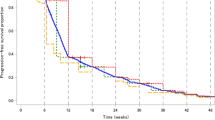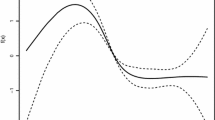Abstract
There are well-established survival analysis methodologies for data sets that are complete, with accurate information on censoring. But what if they are not complete? In this article we consider how to analyze cases where “hidden censoring” occurs, where individuals have effectively left the study but the hospital is unaware of this. We develop a new Markov chain-based methodology for generating survival curves and hazard functions, and demonstrate this using a breast cancer data set from the Kurdistan region of Iraq.
Similar content being viewed by others
References
Al Tamimi, D., A. Mohamed, A. Ayesha, K. Ammar, and A. Amal. 2010. Portion expression profile and prevalence pattern of the molecular classes of breast cancer—A Saudi population based study. BioMed Central Cancer 10 (223):1–13.
Alwan, N. A., W. Al-Kubaisy, and K. Al-Rawaq. 2000. Assessment of response to tamoxifen among Iraqi patients with advanced breast cancer. East Mediterranean Health Journal 6:475–82.
Barlow, R., and F. Proschan. 1975. Statistical theory of reliability and life testing probability models. Austin, TX: Holt, Rinehart and Winston.
Bedford, T., and R. Cook. 2009. Probabilistic risk analysis foundation and methods. New York, NY: Cambridge University Press.
Cox, R., and H. Miller. 1965. The theory of stochastic processes. London, UK: Methuen & Co.
Cox, R., and D. Oakes. 1984. Analysis of survival data. London, UK: Chapman and Hall.
Crowder, M. 2012. Multivariate survival analysis and computing risks. New York, NY: CRC Press.
Crowder, M., A. Kimber, R. Smith, and T. Sweeting. 1991. Statistical analysis of reliability data. London, UK: Chapman and Hall.
De Santis, C., J. Ma, L. Bryan, and A. Jemal. 2014. Breast cancer statistics, 2013. CAA Cancer Journal for Clinicians 64:52–62.
Dey, S., A. S. Soliman, A. Hablas, I. A. Seifeldin, K. Ismail, M. Ramadan, H. El-Hamzawy, M. L. Wilson, M. Banerjee, P. Boffetta, J. Harford, and S. D. Merajver. 2010. Urban–rural differences in breast cancer incidence by hormone receptor status across 6 years in Egypt. Breast Cancer Research and Treatment 120:149–160.
Grimmett, G., and D. Stirzaker. 2001. Probability and random processes, 3rd ed. New York, NY: Oxford University Press.
Haigh, J. 2002. Probability models. London, UK: Springer.
Hughson, M. D. 2012. A population-based study of Kurdish breast cancer in northern Iraq: Hormone receptor and HER2 status. A comparison with Arabic women and United States SEER data. BMC Women’s Health 12 (16):1–10.
Hussaion, A. H., and P. M. Aziz. 2009. The incidence rate of breast cancer in Suleimani Governorate in 2006: Preliminary study. Journal of Zankoy Suleimani 12(1, Part A):59–65.
Lan, N. H., W. Laohasiriwong, and J. Stewart. 2013. Survival probability and prognostic factors for breast cancer patients in Vietnam. Global Health Action, 6:18860.
Lawless, J. F. 2003. Statistical models and methods for lifetime data, 2nd ed. Hoboken, NJ: John Wiley & Sons.
Majid, R. A., H. A. Mohammed, H. M. Saeed, B. M. Safar, R. M. Rashid, and M. D. Hughson. 2009. Breast cancer in Kurdish women of northern Iraq: Incidence, clinical stage, and case control analysis of parity and family risk. BMC Women’s Health 9 (33).
Majid, R. A., H. A. Mohammed, H. A. Hassan, W. A. Abdulmahdi, R. M. Rashid, and M. D. Hughson. 2012. A population-based study of Kurdish breast cancer in northern Iraq: Hormone receptor and HER2 status. A comparison with Arabic women and United States SEER data. BMC Women’s Health 12 (16):1–10.
NHS Choices. 2011. Unhealthy lifestyles linked to UK cancer rates. http://www.nhs.uk/news/2011/01January/Pages/unhealthy-lifestyles-linked-to-UK-cancer-rates.aspx
Othman, R. T., R. Abdulljabar, A. Saeed, S. S. Kittani, H. M. Sulaiman, S. A. Mohammed, R. M. Rashid, and Hussein, N. R. 2011. Cancer incidence rates in the Kurdistan region/Iraq from 2007–2009. Asian Pacific Journal of Cancer Prevention 12 (5):1261–64.
Ozmen, V. 2006. Screening and registering programs for breast cancer in Turkey and in the world. Journal of Breast Health 2 (2):55–58.
Rennert, G. 2006. Breast cancer. In Cancer incidence in the four member countries (Cyprus, Egypt, Israel, and Jordan) of the Middle-East Cancer Consortium (MECC) compared with US SEER, Ed. L. S. Friedman, B. K. Edwards, L. A. G. Reiss, J. L. Young, 73–81. Bethesda, MD: National Cancer Institute, NIH Pub No. 06-5873.
Ries, L. A. G., D. Melbert, M. Krapcho, A. Mariotto, B. A. Miller, E. J. Feuer, L. Clegg, M. J. Horner, N. Howlader, M. P. Eisner, M. Reichman, and B. K. Edwards. eds. 2007. SEER cancer statistics review, 1975–2004. National Cancer Institute.
Robb, C., W. E. Haley, L. Balducci, M. Extermann, E. A. Perkins, B. J. Small, and J. Mortimer. 2007. Impact of breast cancer survivorship on quality of life in older women. Critical Reviews in Oncology/Hematology 62 (1):84–91.
Rudat, V., B. Nuha, T. Saleh, and A. Mousa. 2013. Body mass index and breast cancer risk: A retrospective multi-institutional analysis in Saudi Arabia. Advances in Breast Cancer Research 2:7–10.
Schmoor, C., M. Olschewski, and S. Martin. 1996. Randomized and non-randomized patients in clinical trials: Experiences with comprehensive cohort studies. Statistics in Medicine 15:263–71.
Schumacher, M., G. Bastert, H. Bojar, K. Hubner, M. Olschewski, W. Sauerbrei, C. Schmoor, C. Beyerle, R. L. A. Neumann, and H. F. Rauschecker. 1994. Randomized 2 × 2 trial evaluating hormonal treatment and the duration of chemotherapy in node-positive breast cancer patients. Journal of Clinical Oncology 12 (10):2086–93.
Shabila, N., G. Namir, N. Al-Tawil, S. Tariq, T. Al-Hadithi, S. Egbert, and V. Kelsey. 2012. Iraqi primary care system in Kurdistan region: Providers perspectives on problems and opportunities for improvement. BioMed Central Womens Health 12 (21):1–9.
Sughayer, M. A., M. A. Maha, M. Suleiman, and A. Mahmoud. 2006. Prevalence of hormone receptors and HER2/neu in breast cancer cases in Jordan. Pathology Oncology Research 12 (2):83–86.
World Health Organization. 2008. The global burden of disease: 2004 Update. www.who.int/evidence/bod.
Author information
Authors and Affiliations
Corresponding author
Additional information
Color versions of one or more of the figures in the article can be found online at www.tandfonline.com/ujsp.
Rights and permissions
About this article
Cite this article
Raza, M.S., Broom, M. Survival analysis modeling with hidden censoring. J Stat Theory Pract 10, 375–388 (2016). https://doi.org/10.1080/15598608.2016.1152205
Received:
Published:
Issue Date:
DOI: https://doi.org/10.1080/15598608.2016.1152205




